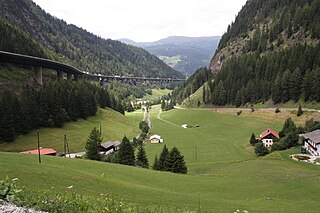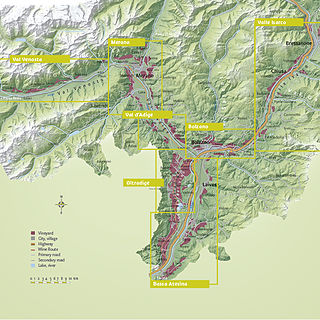
The Brenner Pass is a mountain pass through the Alps which forms the border between Italy and Austria. It is one of the principal passes of the Eastern Alpine range and has the lowest altitude among Alpine passes of the area.

South Tyrol is an autonomous province in northern Italy, one of the two that make up the autonomous region of Trentino-Alto Adige/Südtirol. Its official trilingual denomination is Autonome Provinz Bozen – Südtirol in German, Provincia autonoma di Bolzano – Alto Adige in Italian and Provinzia autonoma de Bulsan – Südtirol in Ladin, reflecting the three main language groups to which its population belongs. The province is the northernmost of Italy, the second largest, with an area of 7,400 square kilometres (2,857 sq mi) and has a total population of 530,009 inhabitants as of 2018. Its capital and largest city is Bolzano.

Ritten is a comune (municipality) in South Tyrol in northern Italy.

Bolzano is the capital city of the province of South Tyrol in northern Italy. With a population of 107,436, Bolzano is also by far the largest city in South Tyrol and the third largest in Tyrol. The greater metro area has about 250,000 inhabitants and is one of the urban centers within the Alps.

Trentino-Alto Adige/Südtirol is an autonomous region of Italy, located in the northern part of the country. Since the 1970s, most legislative and administrative powers have been transferred to the two self-governing provinces that make up the region: the Province of Trento, commonly known as Trentino, and the Province of Bolzano, commonly known as South Tyrol.

Lienz is a medieval town in the Austrian state of Tyrol. It is the administrative centre of the Lienz district, which covers all of East Tyrol. The municipality also includes the cadastral subdivision of Patriasdorf.

The Prince-Bishopric of Brixen was an ecclesiastical principality of the Holy Roman Empire in the present-day Italian province of South Tyrol. It should not be confused with the larger Catholic diocese, over which the prince-bishops exercised only the ecclesiastical authority of an ordinary bishop. The bishopric in the Eisack/Isarco valley was established in the 6th century and gradually received more secular powers. It gained imperial immediacy in 1027 and remained an Imperial Estate until 1803, when it was secularised to Tyrol. The diocese however existed until 1964, and is now part of the Diocese of Bolzano-Brixen.

Badia is a comune (municipality) in South Tyrol, northern Italy. It is one of the five Ladin-speaking communities of the Val Badia which is part of the Ladinia region.

The Puster Valley is a valley in the Alps that runs in an east-west direction between Lienz in East Tyrol, Austria and Mühlbach near Brixen in South Tyrol, Italy. The South Tyrolean municipalities of the Puster Valley constitute the Puster Valley district.

Toblach is a comune/Gemeinde (municipality) in South Tyrol in northern Italy, located in the Puster Valley about 70 kilometres (43 mi) northeast of the city of Bolzano, on the border with Austria.

Rasen-Antholz is a municipality in South Tyrol in northern Italy.

Innichen is a market town and comune (municipality) in South Tyrol in northern Italy.

The South Tyrol Alpine Club, abbreviated AVS, is an association of German and Ladin-speaking mountain climbers in South Tyrol, northern Italy. Founded in 1946, it is sub-divided into 32 sections and 58 local divisions. The AVS is based in Bolzano and has more than 60,000 members.
Oskar Peterlini, Lecturer at the Free University of Bozen Bolzano, is a Representative of the German-speaking South Tyrolean Minority in South Tyrol, Italy. He was a member of the Italian Senate in the Italian Parliament from 2001 to 2013, Member of the Regional Parliament of Trentino South Tyrol from 1978 to 1998 and its President from 1988-1998. He was also President of the district of the South Tyrolean Unterland of the South Tyrolean People's Party SVP, from 2001 to 2010.

The Val Badia is the valley of the Gran Ega river in South Tyrol, Italy. It stretches from the Sella massif northwards to the Puster Valley. The villages in the Val Badia, whose population are predominantly Ladin-speaking, belong to the following municipalities: Badia, Corvara, La Val, Mareo and San Martin de Tor.

Innichen Abbey is a former Benedictine monastery in Innichen, South Tyrol in northern Italy. Founded in the 8th century, its collegiate church dedicated to Saint Candidus, rebuilt in the 12th–13th centuries, is considered the most important Romanesque building in Tyrol and the Eastern Alps. It is home to a 13th-century sculpture and a fresco cycle from the same age in the dome.

Tyrol is a historical region in the Alps; in Northern Italy and western Austria. The area was historically the core of the County of Tyrol, part of the Holy Roman Empire, Austrian Empire and Austria-Hungary, from its formation in the 12th century until 1919. In 1919, following World War I and dissolution of Austria-Hungary, it was divided into two modern administrative parts through the Treaty of Saint-Germain-en-Laye:

South Tyrol is an autonomous province located in north-east Italy producing wine. This Austro-Italian wine region is noted for the distinct Austrian influences on the wine industry due to the region's long history under the rule of Austria-Hungary and Holy Roman Empires.

The earth pyramids of Ritten are a natural monument that is located on the Ritten, a plateau not far from Bolzano in northern Italy. The earth pyramids of South Tyrol are a fairly widespread phenomenon which are existing in various locations.

Karl Felix Wolff was a journalist, poet, author and self-taught folklorist of the South Tyrol who collected and published Ladinian legends.
This page was taken down due to inappropriate behavior.





















